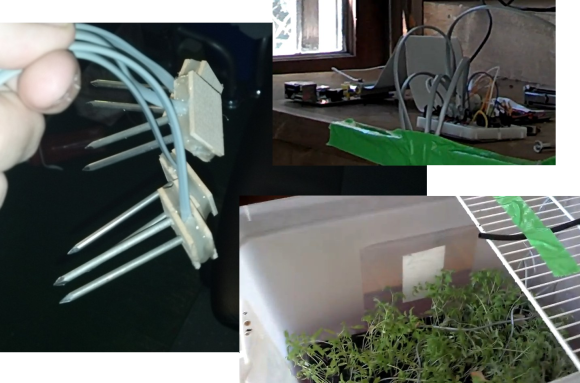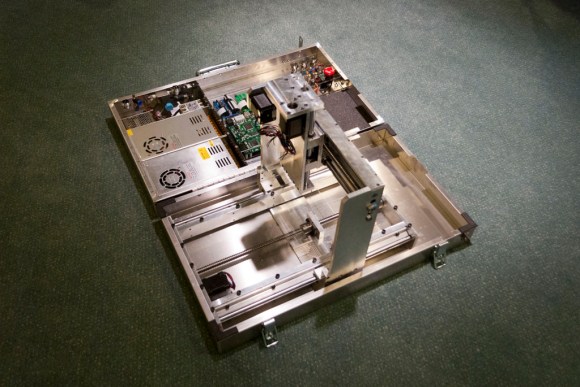Interesting Webinar from C24 around feeding MongoDB with FIX messages. Curious if anyone is using this in production today. The MongoDB aggregation framework can probably full together some nice data once the FIX messages are in MongoDB e.g. the all FIX message for RFQ @time x etc. Matt’s blog posting provides an ExecutionReport sample using C24 code, but unfortunately doesn’t go into the aggregation uses of FIX message once the ExecutionReport’s are in MongoDB
Shared posts
One of the World's Best A.I. Computers Is as Smart as a Four Year Old
Raise the dust
This trailer for Raise the dust, a roadbook rally aired by Red Bull's Servus TV, features four guys going all out on four Triumph Scramblers.
Holy cow! ![]()
This Lego Microscope Actually Works

This working Lego microscope was built by Carl Merriman, a Lego artist who's been building for over 27 years. It's sleek, functional and even though you couldn't use it to study Ebola or the T-Virus, it's still a pretty sweet piece of kit.
ScienceShot: The Sun's Twisted Tail
| The first glimpse down the sun's cometlike tail shows it to be a bit askew |
Source: Science - Discipline: Space
Molecular Wires With 2000% Change In Magnetoresistance!
A new paper appearing in Science today is reporting the properties of a molecular wire that has the capability of having a 2000% increase in its magnetoresistance, and all at room temperature!
Ironically, the new molecular wires aren't made with magnetic materials at all. Rather, their MR effect relies on the conductivity of nonmagnetic organic dye molecules called DXP, which the Italian automaker Ferrari once used to give their roadsters their trademark red color. Unlike conventional inorganic metals in which electrons zip through a crystalline lattice, in organics electrons must hop from one molecule to another, like pails of water being passed by a bucket brigade. To create a MR, material researchers need to switch off that bucket brigade in the presence of a magnetic field.Of course, we all know (don't we?) that this is the field that has been responsible for invention of computer magnetic storage disks, etc. So kids, this is another example of real-world, practical application of physics, and quantum mechanics in particular.
In organic materials researchers do this with a little help from quantum mechanics. A tenet of quantum mechanics called the Pauli Exclusion Principle states that no two fermions (particles in a family that includes electrons) can occupy the same quantum state. If two electrons with the same quantum state try to hop onto the same DXP, they can't. The bucket brigade turns off and resistance skyrockets.
Zz.
The Roku 3 Is Your Deal Of The Day

The Roku 3 is unquestionably the king of the streaming boxes. It's also new, and doesn't go on sale that often. Grab it today for $89 bucks- the lowest price we've seen on it and even more on an easy impulse buy than its MSRP. [Amazon]
50 Debunked Science Misconceptions Will Make You Less Dumb
Being an enlightened individual means understanding basic scientific information about how the world works. Sure, we have teachers and parents there to fill our brains with knowledge, but the sad truth is that there are certain facts that take on a life of their own as they pass from ear to ear, eventually etching themselves into our collective brain-mass in twisted forms that are, well, just plain wrong.
I Wore a Bionic Leg, And I Never Wanted To Take It Off Again
Say you've just had ACL surgery. Or you're recovering from a bad break. Or, worse, you suffer a stroke, or MS, or spinal or neurological damage. Regaining the power to walk is one of the toughest things you can do, and it may be impossible without a crutch, rail, or physical therapist to lean on. The AlterG Bionic Leg—straight out of the sci-fi future—may be the answer you've been dreaming of. I should know. I tried it.
A Comfy Throne That Explodes Into Plush Stools To Seat All Your Guests

A king or queen is nothing without their subjects, so if you're on the hunt for a comfy chair that's worthy of your greatness while not leaving everyone else sitting on the floor, the Quartz marks the end of your search.
This Concrete-Recycling Robot Devours Entire Buildings
Mars Rover 2020: NASA's Heroic Plan to Bring a Chunk of Mars to Earth
What's the Absolute Minimum You Can Compress Data to?
‘Holographic Duality’ Hints at Hidden Subatomic World
Guillemot eggs are self-cleaning
| Guillemot eggs have nano-structures on their shells that have evolved to keep off the seawater and dirt, according to research |
Source: BBC News - Discipline: Evolution
Douglas Engelbart, Inventor of the Computer Mouse, Has Died
Watch a Swirling Alien World Magically Appear in a Test Tube

A lot of your more flashy chemistry experiments are explosion-centric, but there are a few quieter ones that are just as mesmerizing. A mixture of copper sulfate and ammonia, for instance, looks like the surface of an alien gas giant. And when it's in slow motion, it's positively hypnotic.
Netgear's R6100 router hits 802.11ac speeds for $100, available now
The R6100 is the latest addition to Netgear's 2013 router lineup and retails for an easier-to-justify price than its siblings. For $100, the 802.11ac-generating square will connect to the new Macbook Air's upgraded wireless, with a dual 2.4 GHz and 5 GHz a/b/g/n antenna ensuring compatibility with your first-gen Zune. Like the R6200, the now-available R6100 hits 1200 Mbps combined and packs Ethernet for wired connections. It doesn't hit the speeds of the R6300, but, for half the money, what's 550 Mbps among friends?
Filed under: Internet
Via: MacNews
Source: Netgear
Programming is FUNdamental: A closer look at Code.org's star-studded computer science campaign
"All these people who've made it big have their own variation of the same story, where they felt lucky to be exposed to computer programming at the right age, and it bloomed into something that changed their life," explains the organization's co-founder, Ali Partovi, seated in the conference room of one of the many successful startups he's helped along the way. The Iranian-born serial entrepreneur has played a role in an impressive list of companies, including the likes of Indiegogo, Zappos and Dropbox. Along with his twin brother, Hadi, he also co-founded music-sharing service iLike.
Unlike past offerings from the brothers, Code.org is a decidedly non-commercial entity, one aimed at making computer science and programming every bit as essential to early education as science or math. For the moment, the organization is assessing just how to go about changing the world. The site currently offers a number of resources for bootstrappers looking to get started in the world of coding. There are simple modules from Scratch, Codecademy, Khan Academy and others, which can help users tap into the buzz of coding their first rectangle, along with links to apps and online tutorials. The organization is also working to build a comprehensive database of schools offering computer science courses and soliciting coders interested in teaching.
Doug Engelbart (RIP): "The Mother of All Demos"
In memory of computing pioneer Douglas Engelbart, who died last night, please watch this 1968 video of his "Mother of All Demos." Thank you Doug for helping augment human intellect.
"The key thing about all the world's big problems is that they have to be dealt with collectively. If we don't get collectively smarter, we're doomed." - Douglas Engelbart (1925- 2013)
This Bike Made from Kevlar and Fiberglass Might Be the Fastest Bike Ever

It doesn't even look like a bike but according to the wild mind of world-renowned cyclist Graeme Obree, it might be the fastest bike ever. Made from kevlar and fiberglass, the Beastie will be used at the World Human Powered Speed Challenge where Obree wants to break the world record of 82.8 mph. 83 miles per hour on that thing!
Raspberry Pi automates your tomato farm

Check out the tomato plants [Devon] grew using a monitoring system he built himself. It’s based around a Raspberry Pi. As far as grow controllers go it falls a bit short of full automation. That’s because the only thing it can actuate is the black water line seen hovering above the plants. But [Devon's] work on monitoring and collecting sensor data should make it easy to add features in the future.
The moisture sensors pictured above monitor the soil in which the plants are growing. But he also has temperature and light sensors. These are very important when growing from seed and could be used in conjunction with a heating mat for plants that require higher soil temperatures (like pepper plants). The tomatoes are also pretty leggy. Now that he’s monitoring light levels it would be good to augment the setup with a grow light. A long term goal could even be a motorized bed which could raise the plants right up to the bulbs so they don’t reach for the light.
Don’t let the stars in our eyes distract you though. He’s done a ton of work on the project both with the physical build, and in plotting the data collected by the system. Great job!
Filed under: green hacks, Raspberry Pi
Briefcase mill

Take the machine shop with you; that’s the mantra which drove [Ryan] to build this CNC mill in a briefcase. That album will give you a taste of the final product. But you’ll want to dig through two pages of his forum thread starting with this post in order to behold the build process.
The image above is only part way through the fabrication, but we thought it gave the best overall view of his work. It’s missing the cables which connect to the control circuitry in the lid. The bed has also not been installed and this was before he fabricated the protective case for the PCBs.
Getting everything to fit inside of a folding case was quite a trick. Of course he used CAD to make sure it was possible. There are several places where the clearance when closed is about 2mm. We’re shocked by the build quality of the mill itself. It’s a novel idea to make it portable, but the accuracy and reliability of the machine didn’t suffer for the concept.
If you need a desktop mill that’s not quite as portable here’s a project which will dish out some inspiration.
Filed under: cnc hacks
Hackaday looking for a good home
HackADay.com, an awesome maker community, is looking for a new home
——–
tl;dr: HackADay is a passionate community of hackers doing awesome stuff. It deserves more attention than I can give it right now, as I’m ultra-focused on the launch of Inside.com. So, we’re looking for a caring new owner with a stellar track record of not f@#$ing up brands to take it over.
——–
We created HackADay back in 2004 because one of Engadget’s awesome bloggers, Phil Torrone, wanted to do super-geeky projects every day and the Engadget audience wasn’t exactly into that frequency.
In a phone call with PT I said, “So you want to do a hack a day?”
He was like, “Yeah, a hack a day.”
And I was like, “OK, let’s do hackaday.com.”
When we sold Weblogs Inc. to AOL, we took HackADay out of the deal because it was doing stuff that a corporate parent’s legal arm might not feel comfortable with (e.g., hacking cable boxes!).
So, I bought it and kept it safe and warm inside of Mahalo.com for the past couple of years. However, since I’m super focused on the Inside.com launch, I need to find a new home for it.
It’s doing over $14k a month in advertising without a sales force (just AdSense mainly), and it’s got an amazing stable of bloggers. Given its 6m pageviews a month and with an advertising sales force doing a modest $15 RPM, Hackaday could do $90k a month.
We’ve got 5,674 members of our email list after just five months (should have started it 10 years ago, would have been at 100k+ by now!).
We’ve started doing some epic videos on YouTube. Collectively the videos have over 5m views and 31k subscribers: www.youtube.com/hackaday
This awesome video broke 1m views: http://youtu.be/LZkApleQQpk
Our Twitter handle has 29k followers.
We’re hoping someone like Maker, DemandMedia, InternetBrands, AOL (without Time Warner involved!), Gawker or another publisher can carry on this awesome, profitable and limitless brand.
If you’re interested, send a note to jason@inside.com.
Also, HackADay is looking for a new editor-in-chief. Please send sample projects, posts and whatever else you got to neweditor@hackaday.com.
Thanks for allowing me this and for your help with any new home ideas.
best @jason
Filed under: news
Amateur scientists vs. cranks
This is video of a talk given last year by David Dixon, assistant professor of math, science and engineering at Saddleback College in California. He used to work in the Physics Department at California Polytechnic State University, which, like many physics departments around the world, received loads of correspondence from non-scientists who thought they had come up with earth-shattering, game-changing hypotheses that needed to be shared.
Now, sometimes, laypeople come up with good ideas that should be explored. But many of these letters are better classified as the work of cranks — folks who had big ideas, cared deeply about those big ideas, but who were dead wrong ... and utterly impervious to the idea that they might be wrong.
In this talk, Dixon delves into the collection of crank letters received by California Polytechnic State University over the years to explain the hallmarks of crankitude, the behaviors that raise red flags for professional scientists, and what we can actually learn about real science by studying fake science.
YouTube says the video is over two hours long, but that's apparently inaccurate. The actual talk is an hour long and just somehow got loaded twice into the same video.
If this is a topic that interests you, I'd also recommend reading this MetaFilter thread, where scientists explain to a poster why the poster's friend is setting off crank red flags with scientists whose attention he's trying to capture. It's a fascinating look at what to do and what not to do if you have a hypothesis you want to share.
Makedo: connectors for cardboard construction fun


My kids (7 and 4) love to make things out of recycled cardboard, from curious Rube Goldberg-ian contraptions to palaces for stuffed animals. They do wonders with scissors, tape, and magic markers. A friend told us about Makedo, a system of reusable plastic clips and hinges for cardboard construction. We ordered a set and have been having a ball. The sets even come with a plastic saw for cutting the cardboard. It's not as quick as a box cutter or sharp scissors, but sawing itself can be fun, and the point on the saw handle is meant for punching holes for the clips. And yeah, I guess it's safer too. We didn't make the cardboard gorilla at right but I'd like to! We're gonna need a lot more clips though. There are a variety of Makedo kits available but the 65-piece starter kit is only $14 from Amazon, and comes in a sturdy tube. Of course, if you buy it from Amazon, the shipping box is part of the present! "Makedo FreePlay Kit For One"![]()
Pocket Spacecraft launches crowdsourced lunar mission on Kickstarter (video)
As space exploration becomes democratized, the entry price for such endeavors has fallen dramatically. One company taking advantage of this is Pocket Spacecraft, a Bristol-based enterprise that thinks it can send thousands of personalized probes to the heavens for a few hundred dollars apiece. While it may look more like a used coffee filter, the Earth Scout / Lunar Scout is a CD-sized, paper-thin probe that contains a bonded solar cell, system-on-a-chip and antennas. Several thousand of these will be loaded onto a CubeSat and then dropped onto Earth or the Moon, depending on your project and contribution. Users who cough up the cash will then be able to observe how thin, papery probes journey downward, with telemetry being sent to an Android / iOS app. Anyone interested in backing the project on Kickstarter should check out the video after the break and then empty their savings of £99 ($150) to buy an Earth scout or £199 ($302) if they intend to explore the Moon.
Filed under: Transportation, Science
Source: Kickstarter
Telescopic contact lenses magnify sight 2.8 times, turn wearer into cyborg
Interested in upgrading your eyeballs? Well, a team of DARPA-funded researchers led by Joseph Ford of UC San Diego recently published a proposal for a new type of telescopic contact lens in Optics Express. Designed for people with age-related macular degeneration, the lenses are only 1.17mm thick and can magnify images up to 2.8 times. Their layered construction admits light near the outer edge of the lens, bouncing it across a series of tiny aluminum mirrors before transmitting it to the back of the retina, kind of like the origami-optics lens. Telescopic sight can be toggled on and off by using a pair of 3D glasses to switch the polarization of the central part of the lens. It sounds promising, but the lenses -- pictured after the break -- currently have some obstacles, like gas-impermeable materials unsuitable for long-term wear and sub-par image quality. Want to read more? Pop on your glasses and check out the full paper at the source link below.
Via: Extreme Tech
Source: Optics Express (PDF)
WakeVoice Is an Alarm Clock That Talks To You (and You Can Talk To)

Android: We've covered several Android alarm clocks, but WakeVoice is different. Instead of waking up to music, WakeVoice rings, then speaks to you when it's time to get up. It can play a personalized message, read the news headlines, or fill you in on the weather for the day, all while you drag yourself out of bed.
Reverse engineering a wireless protocol

Like all good tinkerers, [Andrew] decided to figure out how his wireless security system worked. Yes, it’s an exercise in reverse engineering, and one of the best we’ve seen to date.
After breaking out the handheld spectrum analyzer and TV tuner SDR, [Andrew] cracked open a few devices and had a gander at the circuit boards. The keypad, PIR sensor, and base station all used a TI radio chip – the CC11xx series – that uses SPI to communicate with a microcontroller.
Attaching a logic analyzer directly to the radio chip and reading the bits directly, [Andrew] started getting some very good, if hard to understand data. From the security system specs, he knew it used a ’20-bit code’, but the packets he was reading off the SPI bus were 48 bits long. The part of this code was probably the system’s address, but how exactly does the system read its sensors?
The easiest way to figure this out was to toggle a few of the sensors and look at the data being transmitted. With a good bit of reasoning, [Andrew] figured out how the alarm system’s code worked. This theory was tested by connecting one of the radios up to an Arduino and having his suspicions confirmed.
While [Andrew]‘s adventure in reverse engineering is only a benefit for people with this model of security system, it’s a wonderful insight into how to tear things apart and understand them.
Filed under: wireless hacks
















